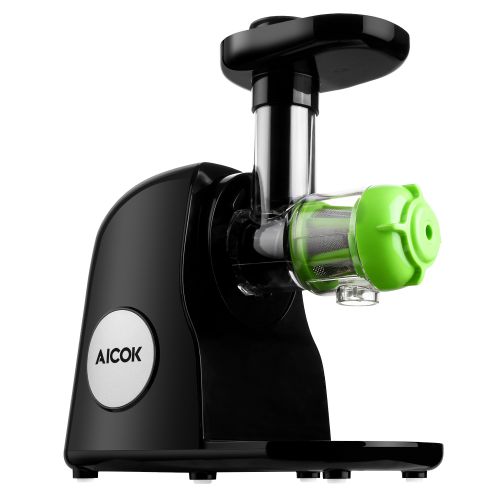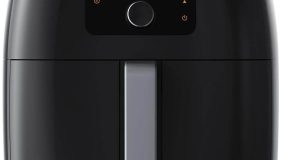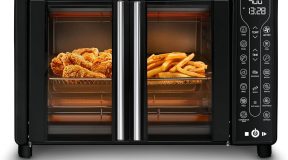Juicers are a great invention that let you benefit from the nutrients of fruits and vegetables quite easily. They aren’t as basic and straightforward as blenders, however, so choosing one might be a little bit harder. To make the right choice, you’ll need to have a good background regarding the types of juicers and what each of them is good for.
In this article, we’ll be explaining in detail how each type works and why you should or shouldn’t buy it.
The Types of Juicers:
1. Centrifugal Juicers
2. Masticating (Cold-Press) Juicer
3. Twin Gear (Triturating) Juicer

Firstly: Centrifugal Juicers
The centrifugal juicers are the most common ones as they’re more affordable and simple – they resemble a blender in the way they work. At first, a blade cuts the vegetables or fruits open. Then, the spinning mechanism works on separating the juice from the pulp.
After the juice has been extracted, it’s passed through a small strainer to be separated from the pulp. Then, a smaller container receives the juice after it has been filtered. The pulp remains on the surface of the strainer in order for the user to dispose of it in their preferred way.
Centrifugal juicers can work with hard produce, citrus fruits, and soft fruits.
Who Should Buy a Centrifugal Juicer?
If you’re looking for speed, simplicity, and efficiency, the centrifugal juicer is the one for you. Centrifugal juicers come with large chutes so you don’t have to chop your produce too much and quick blades that make their performance quite fast.
On top of that, they’re the most affordable option when it comes to juicers. This can be attributed to their availability on the market.
Who Should Skip on the Centrifugal Juicers?
If you’re going to be doing a lot of juicing, then you’ll need a juicer that thoroughly extracts the juice from the produce –a feature that centrifugal juicers aren’t as great at. Their fast performance makes them less thorough than masticating juicers or twin gear ones.
Moreover, due to the speed at which these juicers work, they’re more prone to overheating. This leads to the oxidation of the juice, which means that it would lose a considerable deal of its nutrients.
This is why the juice produced by centrifugal has a shelf life of only 24 hours –quite inferior to the other types of juicers.
Secondly: Masticating Juicers or Cold-Press Juicers
These juicers run on a single speed which is quite slow compared to the centrifugal’s speed. In this slowness lies its biggest advantage –thorough extraction of juicers from fruits or vegetables.
Moreover, its mechanism includes crushing the fruit or vegetable and turning it into a mesh. Having the juice flowing from the mesh is another reason the pulp produced by the juicer is so dry. Masticating juicers can work with hard produce, citrus fruits, soft fruits, leafy greens, and nuts and beans.
Who Should Buy a Masticating Juicer?
If you’re looking for the maximum yield, you should definitely go for a masticating juicer –or even a twin gear one if your budget is expandable.
On top of that, if you want to keep the most nutrients in your juice, then the heat prevention on a masticating juicer would suit you well.
The fact that the juicer works on a slow gear means that it wouldn’t overheat or put a lot of strain on the motor –giving this juicer an advantage in durability.
Who Should Skip on Masticating Juicers?
If you want to be as quick and time-efficient as possible, a masticating juicer isn’t the one for you.
Moreover, if you can’t bother with chopping your produce into the tiniest possible size, you probably wouldn’t appreciate how you have to do that with a masticating juicer.
Thirdly: Twin Gear Juicers
In a twin gear juicer, two gears interlock and shred together to make sure that every drop of juice is squeezed out from the fruit.
Moreover, if you’re going to be working with leafy vegetables, a twin gear juicer is your best bet as it’s the ideal type of juicer to extract the maximum amount of vegetable juice. However, they’re not very compatible with wheatgrass due to the dryness.
Make sure you have flax oil around to lubricate your gear. Otherwise, a lot of foam will result from friction. Twin gear juicers are capable of working with hard produce, citrus fruits, soft fruits, leafy greens, and nuts and beans.
Who Should Buy a Twin Gear Juicer?
If you’re looking for the ultimate maximum amount of yield (especially with leafy greens), this is the juicer for you. On top of that, it also extracts the maximum amount of nutrients and produces juices with a 72-hour shelf life.
Who Should Skip on Twin Gear Juicers?
If you’re on a tighter budget, twin gear juicers will just rub salt into the wound. Moreover, they require some manual handling in order for the fruit to be pushed down the chute.
Add to that, their assembly and cleaning are quite difficult due to the fact that they consist of a lot of parts.
Final Thoughts
Understanding the different types of juicers helps you pick the best option for yourself which will help you achieve your desired results.
The largest amounts of yield are produced by masticating juicers. On the other hand, centrifugal juicers are great for speed and efficiency. And finally, twin gear juicers are the most powerful and retain the most nutrients.






1 Comment
Vernell Endo
(December 25, 2019 - 5:12 am)Wow, this article is pleasant, my younger sister is analyzing these kinds of things, so I am going to tell her.